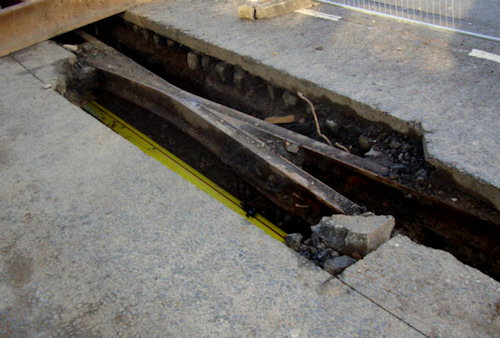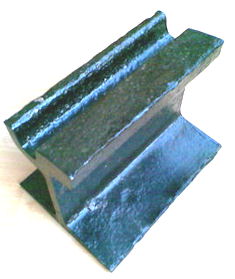Tramcars in the Vale of Leven
It must have been more than fifty years ago when a new sewer line was laid down the middle of Bank Street. The tar-macadam was removed to reveal cobblestones underneath and what was that—tramlines! As a youngster, perhaps more than anything else, these tramlines sparked my interest in the history of the Vale. Where did the lines come from? Where did they go to? What colour were the trams—were they red like all the S.M.T. buses of the day, and when did the service cease?
They certainly went over Bonhill Bridge as the lines could be seen when the decking was removed a few years later to realign the expansion rollers. In those days, the good people of the Vale were not well served with local history resources and it was many years later that the full story was told and an excellent history of the trams was forthcoming.
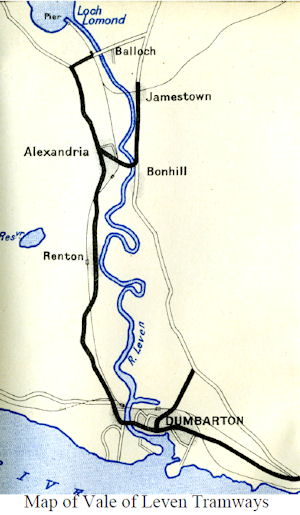 The origins of the trams in the Vale owe much to their success in Glasgow and the expansion of the system to smaller towns in the Clyde valley. Although there was a
proposal as early as 1900 to extend the tramways of Glasgow from Scotstoun to Balloch by way of Dumbarton, Renton and Alexandria, coming down Bridge Street and through
Jamestown, the project did not gain approval. Bonhill Parish Council was in favour but Lord Overtoun, Lord Lieutenant of the County was able to sustain the opposition of the county on the basis of the narrowness of the county roads.
The origins of the trams in the Vale owe much to their success in Glasgow and the expansion of the system to smaller towns in the Clyde valley. Although there was a
proposal as early as 1900 to extend the tramways of Glasgow from Scotstoun to Balloch by way of Dumbarton, Renton and Alexandria, coming down Bridge Street and through
Jamestown, the project did not gain approval. Bonhill Parish Council was in favour but Lord Overtoun, Lord Lieutenant of the County was able to sustain the opposition of the county on the basis of the narrowness of the county roads.
Another attempt was made in 1903, linked to the successful proposal to construct tramways in the Burgh of Dumbarton but construction was delayed while discussions were held on a cheap source of electricity involving the construction of a hydro-electric power scheme at Loch Sloy in connection with the Kosmoid enterprise at Dumbuck.
By 1905 an agreement was reached with the Clyde Valley Power Company that not only allowed the laying of tramways but also provided for improvements to the roads and electric street lighting for the whole length of the line.
Authorization was given on 21st December, 1906, for a line to connect with the Dumbarton Burgh Tramways at Dalreoch, along the Renton Road, through Main Street in Renton, Main Street in Alexandria, along Balloch Road, terminating close to the west side of the Railway level crossing at Balloch Station.
A further line ran from the Fountain, down Bank Street and across Bonhill Bridge, terminating at Levenbank Terrace on the south side of the Railway crossing at Jamestown Station. The newly expanded company would be called the Dumbarton Burgh and County Tramways Co. Ltd.
At the same time, a line connecting the Dumbuck Terminus of the Dumbarton Burgh Tramways with Dalmuir provided for connections with the Glasgow Corporation Tramways although a through connection across the Forth and Clyde Canal was not provided until 1914 when the bridge at Dalmuir was replaced.
Work on the Vale of Leven part of the project began early in 1908 and by the beginning of May a service was in operation between Dumbuck and Alexandria. By the middle of June, the line to Balloch was opened. A single track with strategically placed passingplaces served for the service although the track along most of Main Street Alexandria was doubled.
The new trams for the service to Balloch were “open top”, suitable for a tourist route through the pleasant Vale but rather impractical given the vagaries of the Vale weather. They were clad in an attractive green and cream livery and could accommodate 22 seated passengers inside with 33 on top. They were allowed a maximum speed of 12 m.p.h.
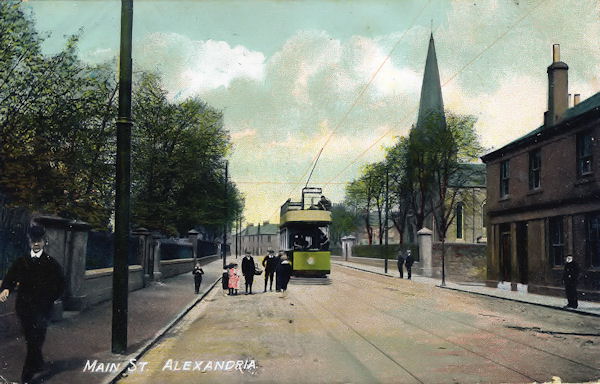
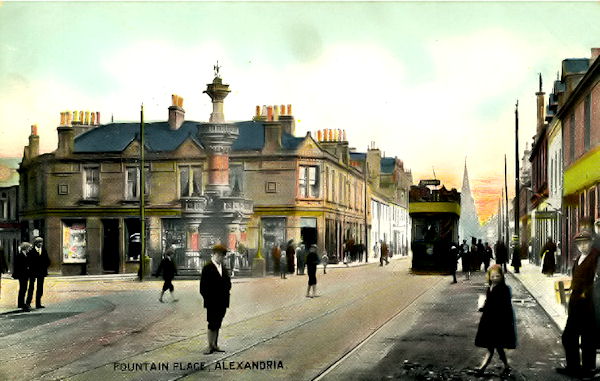
The normal service provided for trams at 15 minute intervals working the 11 mile route between Dalmuir and Balloch. During the summer weekends, the new service attracted great crowds of passengers from Glasgow who found that they could reach the delights of Loch Lomond for modest sum of 7d each way from the Dalmuir terminus. When the weather was fine, every available tram was employed.
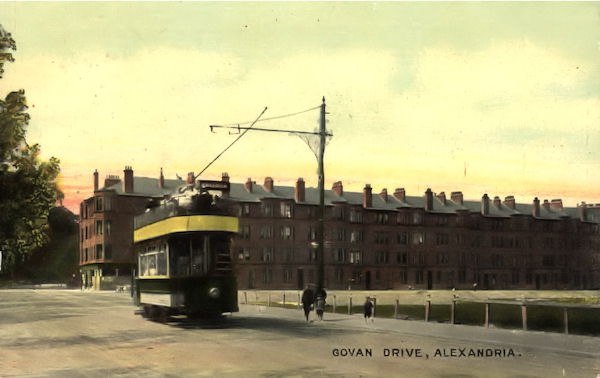
NOTE: Local man Tom Dennett took this picture of a crossover in the tram lines, which are still buried under the road between Alexandria and Balloch. This picture was taken in autumn 2012 when the road was being excavated during the installation of the services for the new Medical Centre. This is opposite the old Torpedo Factory and not far from the position of the tram in the Govan Drive image above.
The original cobble stones that once formed the road surface can also be seen. It is interesting to note that the yellow utility pipe for the new building has been installed underneath the tram lines, which no doubt form some sort of protection for the pipes so the old lines are still proving useful today.
Locally, the trams were a boon to local businesses, helping the growth of Alexandria as the local shopping center and providing fast and efficient transport for workers. Employees in the print- and dye-works on the west bank of the Leven had greater flexibility in seeking work and the new Argyll Motor Works at the north end of Alexandria that had opened in 1906 was directly on the tram line.
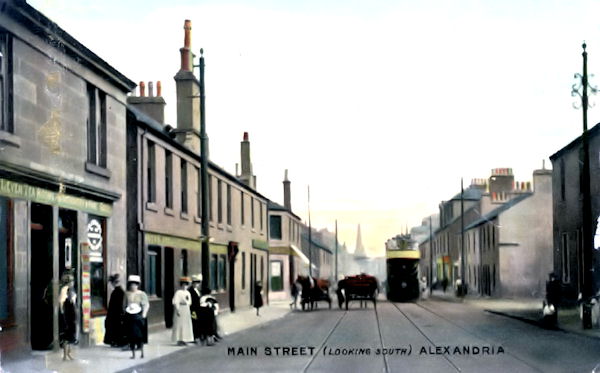
Completion of the branch linking the Fountain with Jamestown and was delayed by the low clearance under the railway bridge in Bank Street. A proposal to lower the level of the road-bed was denied and the compromise reached employed trams in which passengers were not allowed on the upper deck. Four second-hand trams were purchased from Glasgow Corporation for this service that began in February 1909. They had been built more than a decade before and had been converted from horse-trams. These “Jimston caurs” provided a service every 30 minutes for 1d, irrespective of the distance travelled.
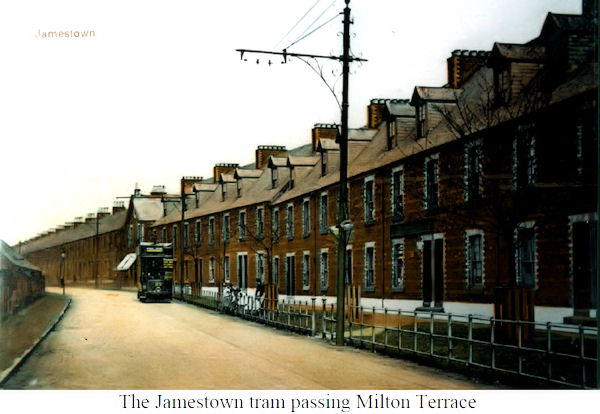
Some early coloured postcards show the tramcars in maroon or brown livery. This appears to originate from the original colour-scheme of the Dumbarton Burgh Tramways, but by the time the line opened to the Vale, green prevailed.
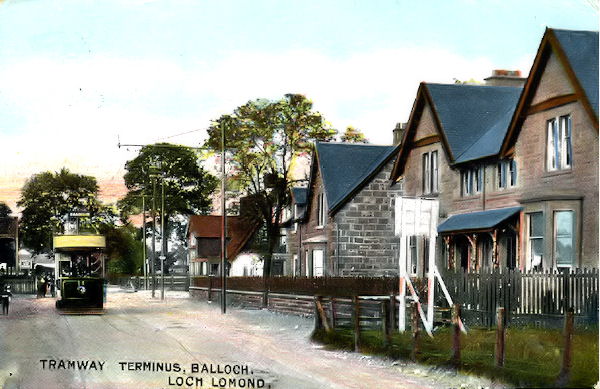
Although Glaswegians could reach Balloch in large numbers and sample the delights of
the village, especially on Sundays when they were considered bona fide travelers and
could be served alcoholic beverages in the local hotels—at greatly inflated prices, access
to Loch Lomond at Balloch was limited and there can be little doubt that the trams
contributed to the demonstrations for public access that took place between 1910 and
1912 and were not resolved until Glasgow Corporation purchased part of the Balloch
estate at the end of 1915. By that time, Britain was at war and in the ensuing manpower
shortage, first women conductresses and then women drivers were introduced. In 1918,
the Jamestown service was withdrawn and only reinstated in 1919 after local protests.
The Jimston Caur
(This poem appeared in the local paper just after the Armistice in 1918)
Oh will ye no come back again,
We miss you unco sair,
I sometimes gang tae Jimston,
But dinna see ye there.
I winner whit’s come ower ye,
Hae ye left us a’ oor lane?
I winner could we coax ye,
Wull ye no come back again?
We canna ca’ ye elegant,
We canna say yer braw,
But, losh, ye swanked it no’ sae bad
Gaun bye the Cannon Raw.
I dinna think ye rin as fast’s
A Caley workman train,
But we dinna care a fig if ye
Wid jist come back again
I winner if the heid yin
Steyed roon by Jimston Dam,
Wid like if he wis left at nicht
Withoot his toddlin’ tram.
I’m thinkin’ we wid hear him grouse
An’ use his fertile brain,
To reason wi’ the powers that be,
Tae send ye back again.
Noo that the nichts are cauld and dark,
We need ye unco sair;
We wish ye wid come back again,
I’m sure ye’ll think that’s fair,
We’ll gie ye aye yer richtfu’ place,
We’ll ca’ ye a’ oor ain,
We’ll cheat nae mair, we’ll pay oor fare,
So please come back again.
Jimston Dam, Dumbarton Herald, November 20th, 1918.
There was a resurgence in tourism after the first world war promoted by well publicized materials on Loch Lomond Park but post-war inflation took its toll with the fare from Dalmuir to Balloch rising to 1/3d. Construction of the Boulevard began in 1923, emphasizing the rise in of motor transport and unregulated competition from large and small bus operators spelled doom for the tramways. The company went into liquidation in 1928 and within a year or two, overhead wires and poles were removed and the streets paved over with asphalt.
Bibliography
Eyre-Todd, G., Glasgow and its Neighbourhood by the Tramway Car Routes, Official Guide, Glasgow Corporation Tramways, Glasgow 1908.
Brotchie, T. C. F., The Braes of Balloch, Glasgow Corporation, Glasgow, 1920.
Brotchie, A. W., and Grieves, R. L. Dumbarton’s Trams and Buses, NB Traction, Dundee, 1985.

